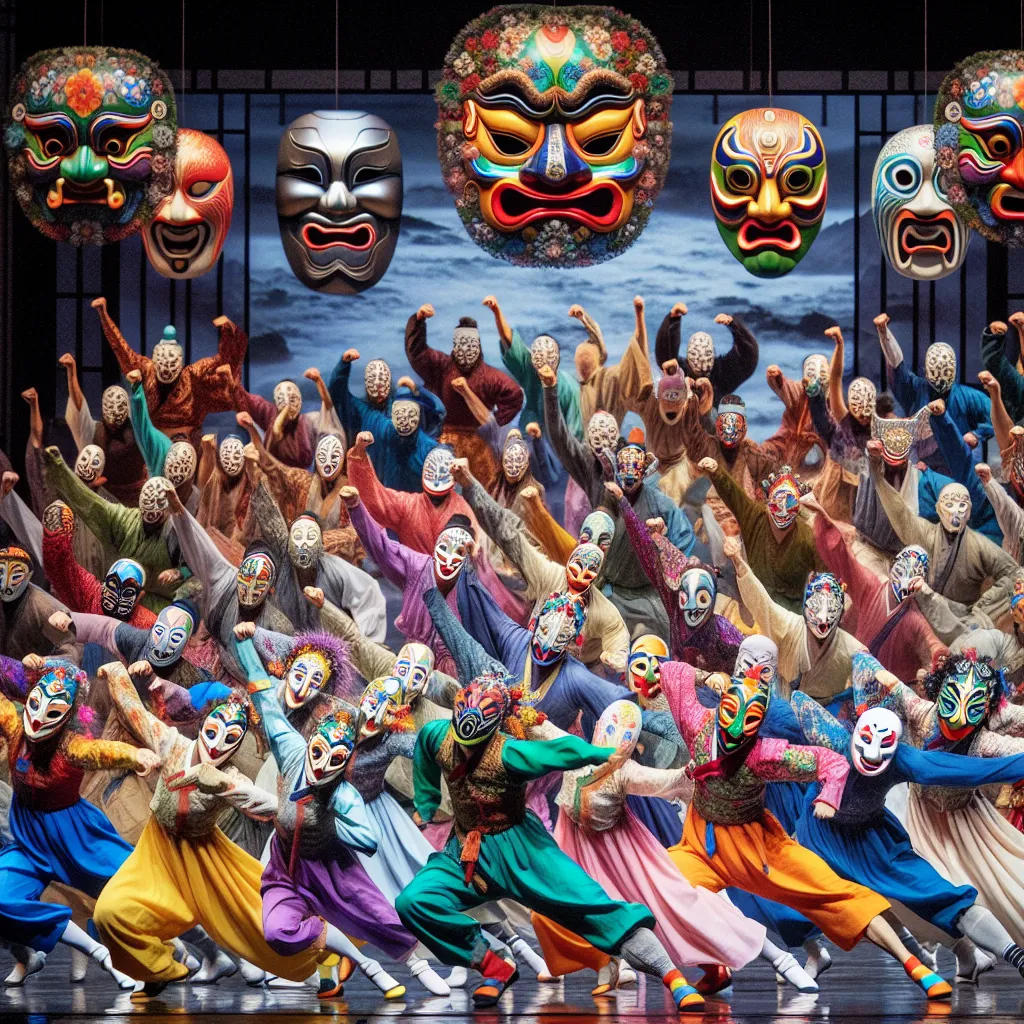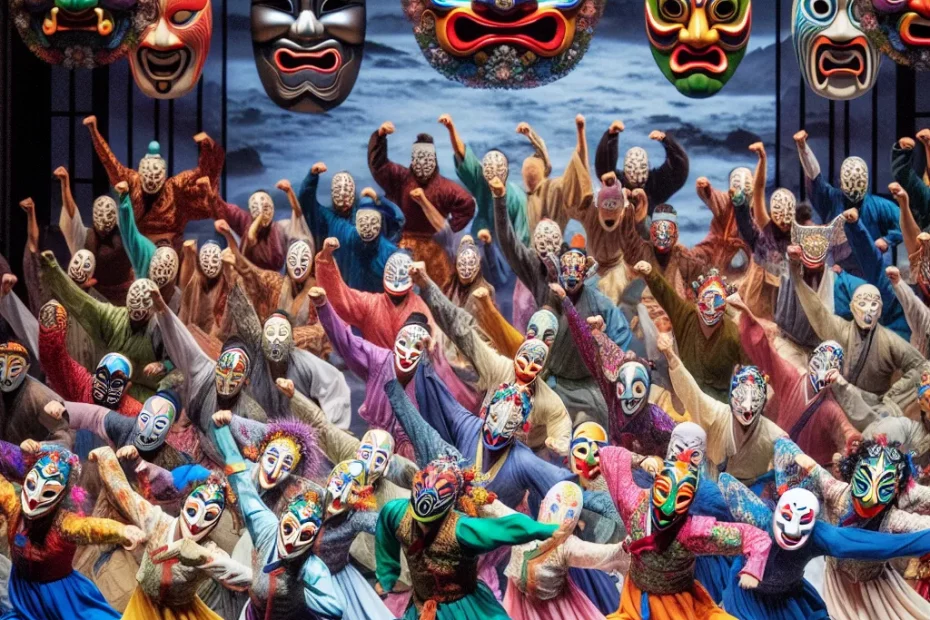The Jeongeup Ogwangdae Mask Dance Drama holds a significant place in Korean cultural heritage, with a history dating back centuries. This traditional art form, characterized by vibrant masks and dynamic performances, offers a window into the rich tapestry of Korean folklore and history. The origins and evolution of Ogwangdae reflect the resilience and creativity of Korean artists throughout the ages, showcasing a unique blend of shamanistic and Buddhist influences. The symbolism behind the masks adds depth and intrigue to the performances, inviting audiences to explore the deeper layers of meaning embedded in each character. Despite facing challenges over the years, modern-day efforts to revive and preserve Ogwangdae highlight the enduring value of this cultural treasure. As we delve into the captivating world of Jeongeup Ogwangdae, we uncover a story of tradition, artistry, and the timeless spirit of Korean culture.

Origins and Evolution of Ogwangdae Mask Dance Drama
The mesmerizing art form of Ogwangdae Mask Dance Drama has a rich history that dates back centuries in Korean culture. Originating from Jeongeup, a city in North Jeolla Province, this traditional performance combines music, dance, and storytelling in a unique and captivating way. 🎭
The Roots of Ogwangdae
The roots of Ogwangdae can be traced back to the Goryeo Dynasty in the 10th century, where it was initially performed as a shamanistic ritual to drive away evil spirits and bring blessings to the community. Over time, the art form evolved, incorporating elements of Confucianism and Buddhism, and became a popular form of entertainment during festive occasions and celebrations. 💃🏻🎶
Distinctive Features of Ogwangdae
One of the most distinctive features of Ogwangdae is the use of masks, each representing a specific character with its own personality and role in the performance. These intricately crafted masks are not only visually striking but also serve as a means for the performers to express a wide range of emotions and narratives. 🎭🤔
Evolution of Ogwangdae
As Ogwangdae gained popularity throughout the Joseon Dynasty, it underwent further refinement and codification, with specific dance movements, musical accompaniment, and storytelling techniques being established. The drama became a cherished cultural treasure, passed down from generation to generation, preserving the traditions and values of Korean society. 🏯🌟
Modern Times and Enduring Appeal
In modern times, Ogwangdae continues to thrive as a beloved art form, with performances being held at various cultural events, festivals, and theaters across South Korea. Its enduring appeal lies in its ability to transport audiences to a world of myth and legend, where the past and present converge in a mesmerizing display of talent and artistry. 🎭✨
Testament to Korean Performing Arts
The evolution of Ogwangdae Mask Dance Drama is a testament to the enduring power of traditional Korean performing arts, showcasing the resilience and creativity of a culture that continues to inspire and captivate audiences around the world. 🌏🇰🇷
As we delve deeper into the origins and evolution of Ogwangdae, we uncover a treasure trove of history, artistry, and cultural significance that continues to enrich and enlighten us to this day. 🎭📜
🌟🎶🎭 Let the enchanting rhythms and vibrant colors of Ogwangdae Mask Dance Drama take you on a journey through time and tradition! 🌟🎶🎭
Symbolism and Meaning Behind the Masks
The Jeongeup Ogwangdae Mask Dance Drama, a traditional Korean performance art form, is steeped in rich symbolism and meaning. Each mask used in this captivating dance drama carries a unique significance, reflecting cultural beliefs, historical narratives, and spiritual connections.
The “Halmi” Mask
The “Halmi” mask, depicting an old woman, symbolizes wisdom, longevity, and the matriarchal presence in society. With its serene expression and gentle features, the Halmi mask embodies the nurturing and protective nature of maternal figures, offering blessings of prosperity and good fortune to the audience.
The “Yangban” Mask
In contrast, the “Yangban” mask represents the aristocratic class in Korean society, characterized by its refined features, intricate designs, and elaborate headdress. This mask symbolizes power, authority, and social hierarchy, reflecting the historical influence of the noble class in shaping Korean culture and traditions.
The “Beggar” Mask
The “Beggar” mask, worn by performers portraying lower-class characters, embodies humility, resilience, and the human experience of overcoming adversity. Through exaggerated facial expressions and tattered costumes, the Beggar mask conveys the struggles faced by marginalized individuals, highlighting themes of empathy, compassion, and social justice.
The “Tiger” Mask
Furthermore, the “Tiger” mask, a prominent symbol in Korean folklore and mythology, represents strength, courage, and the primal forces of nature. Adorned with fierce expressions, sharp fangs, and vibrant colors, the Tiger mask exudes a sense of power and vitality, captivating audiences with its dynamic movements and energetic performances.
As the dancers don these masks and embody their respective characters, they bring to life a tapestry of emotions, narratives, and cultural heritage. The Jeongeup Ogwangdae Mask Dance Drama serves not only as a form of entertainment but also as a profound reflection of Korean identity, values, and traditions, preserving the essence of the past while celebrating the vibrancy of the present.
In essence, the masks used in the Jeongeup Ogwangdae Mask Dance Drama serve as powerful symbols, each carrying a unique story, message, and connection to the collective consciousness of Korean society. Through their intricate designs, expressive features, and symbolic meanings, these masks transcend mere theatrical props, becoming vessels of cultural significance, artistic expression, and historical legacy.
Witnessing the mesmerizing performances of the Jeongeup Ogwangdae Mask Dance Drama, one cannot help but be drawn into a world where tradition meets innovation, where symbolism intertwines with storytelling, and where the masks themselves become gateways to a deeper understanding of Korean culture and heritage. Embrace the magic, the mystery, and the meaning behind the masks, and embark on a journey of discovery through the captivating realm of the Jeongeup Ogwangdae Mask Dance Drama! 🎭🌟
Influence of Shamanism and Buddhism in Ogwangdae
The Jeongeup Ogwangdae Mask Dance Drama, a traditional Korean performing art, is deeply rooted in the influences of Shamanism and Buddhism. The intricate movements, vibrant costumes, and symbolic masks all carry traces of these ancient spiritual traditions, adding layers of meaning and depth to the performance.
Shamanism in Ogwangdae
Shamanism, with its belief in spirits and the supernatural, is reflected in the ritualistic elements of Ogwangdae. The dancers, wearing elaborate masks representing various characters, embody spirits and deities, channeling their energy through dynamic movements and gestures. This connection to the spiritual realm is a central aspect of Shamanistic practices, where performers act as mediums between the human world and the divine.
Buddhism in Ogwangdae
On the other hand, Buddhism’s influence can be seen in the moral and ethical themes woven into the narratives of Ogwangdae. Many of the stories depicted in the performances revolve around the struggle between good and evil, the consequences of one’s actions, and the pursuit of enlightenment. These themes resonate with Buddhist teachings on karma, compassion, and the path to spiritual awakening.
Cultural Fusion in Ogwangdae
The fusion of Shamanism and Buddhism in Ogwangdae creates a rich tapestry of cultural heritage, blending ancient beliefs with moral teachings to entertain, educate, and inspire audiences. The performances serve not only as entertainment but also as a reflection of Korea’s spiritual and philosophical traditions, preserving and celebrating the country’s cultural identity.
Visual Elements of Ogwangdae
The visual elements of Ogwangdae, such as the intricate masks and colorful costumes, are also influenced by Shamanistic and Buddhist symbolism. The masks, often crafted with meticulous detail, represent a wide range of characters from folklore, mythology, and religious stories. Each mask carries its own significance, embodying traits, emotions, and archetypes that resonate with the spiritual themes of the performance.
Evolution of Ogwangdae
Through the centuries, Ogwangdae has evolved and adapted, incorporating new elements while staying true to its roots in Shamanism and Buddhism. Today, it stands as a cultural treasure, a living testament to Korea’s rich heritage and spiritual traditions. The enduring popularity of Ogwangdae reflects its timeless appeal and the universal themes it explores, making it a beloved art form cherished by audiences around the world.
In conclusion, the influence of Shamanism and Buddhism in Ogwangdae is profound and multifaceted, shaping not only the performance itself but also the cultural significance and spiritual depth it embodies. By embracing these ancient traditions, Ogwangdae continues to captivate and inspire audiences, carrying forward the legacy of Korea’s artistic and spiritual heritage with grace and reverence.
Modern-day Revival and Preservation Efforts
In the realm of cultural heritage, the Jeongeup Ogwangdae Mask Dance Drama stands as a true gem, embodying centuries of tradition and artistry. This captivating art form, originating from the Jeongeup region in South Korea, has a rich history dating back to the Joseon Dynasty. The Ogwangdae performances, characterized by vibrant masks and dynamic movements, have long been celebrated for their unique blend of dance, music, and storytelling.
Challenges Faced by Ogwangdae
However, as time passed, the Ogwangdae tradition faced challenges in maintaining its relevance and popularity in modern society. With changing cultural landscapes and shifting priorities, there arose a pressing need to revitalize and preserve this invaluable cultural heritage. In response to this call, dedicated individuals and organizations have embarked on ambitious efforts to ensure the survival and flourishing of the Jeongeup Ogwangdae Mask Dance Drama.
Initiatives for Revival
One notable initiative that has played a crucial role in the revival of Ogwangdae is the establishment of cultural preservation societies and institutions. These organizations work tirelessly to document, research, and promote Ogwangdae through various educational programs, performances, and exhibitions. By raising awareness and fostering appreciation for this traditional art form, they have succeeded in attracting a new generation of enthusiasts and supporters.
Digital Age and Preservation
Furthermore, the digital age has opened up exciting possibilities for the preservation and dissemination of Ogwangdae. Online platforms and digital archives now offer unprecedented access to historical records, videos, and resources related to Ogwangdae. This digital revolution has not only facilitated research and study but has also enabled Ogwangdae to reach a global audience, transcending geographical boundaries and cultural barriers.
International Promotion
In addition to technological advancements, collaborations with academic institutions and cultural exchange programs have played a pivotal role in promoting Ogwangdae on the international stage. Through partnerships with universities, museums, and cultural organizations worldwide, the Ogwangdae community has been able to showcase its artistry and heritage to diverse audiences, fostering cross-cultural dialogue and appreciation.
Future Outlook
As we look to the future, the continued success and sustainability of the Jeongeup Ogwangdae Mask Dance Drama rely on ongoing support and engagement from all quarters. By embracing innovation, preserving tradition, and fostering collaboration, we can ensure that this cultural treasure continues to inspire and captivate audiences for generations to come. Let us join hands in celebrating and safeguarding the legacy of Ogwangdae, a true masterpiece of Korean cultural heritage! 🎭🌟
The Jeongeup Ogwangdae Mask Dance Drama stands as a cultural treasure with a rich history that dates back centuries. From its origins as a form of entertainment for the common people to its evolution into a symbolic representation of Korean folklore and traditions, Ogwangdae has played a significant role in preserving the country’s cultural heritage. The masks used in the performance carry deep meanings and symbolize various aspects of life, spirituality, and human emotions. Influenced by both shamanism and Buddhism, Ogwangdae reflects the spiritual beliefs and practices of the Korean people. Despite facing challenges over the years, modern-day efforts to revive and preserve Ogwangdae highlight its enduring significance in Korean culture. The intricate dance movements, vibrant costumes, and mesmerizing music of Ogwangdae continue to captivate audiences and serve as a reminder of Korea’s rich cultural identity.
